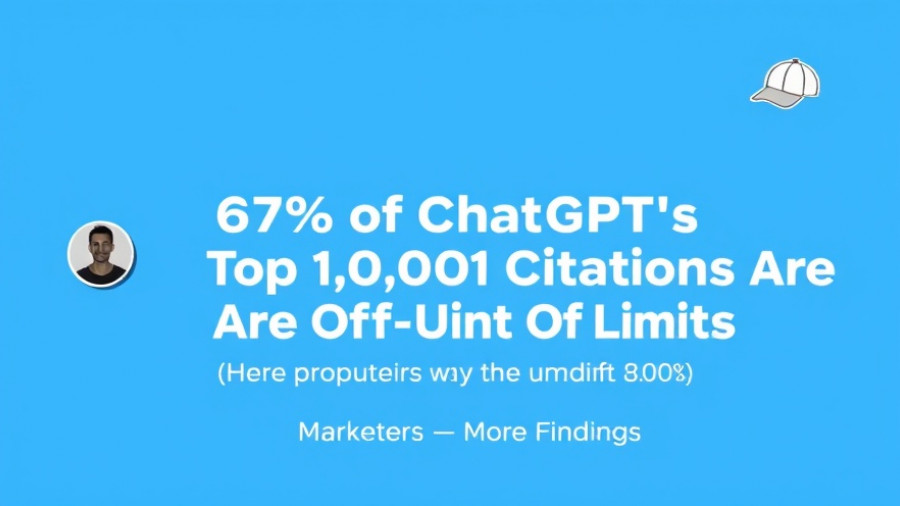
Understanding ChatGPT’s Citation Landscape
In September 2025, an intriguing analysis conducted using Ahrefs Brand Radar revealed the types of content that ChatGPT is citing. Out of a thousand pages examined, a staggering 67% of references are practically inaccessible for marketers—a finding that shifts the focus for small and medium-sized businesses who rely on AI content generation. Businesses that are aiming to enhance their visibility in AI tools need to understand this shifting landscape.
The Dominance of Wikipedia and Educational Content
According to the study, Wikipedia stands out as the most-cited source within ChatGPT, dominating the citations above all other page types. This is not just an incidental finding; it highlights an important trend in how AI interacts with information. Classifying sources is a vital practice, as ChatGPT appears to favor structured, reference-style documents that effectively summarize topics. It’s evident that to maximize the chance of being cited, businesses should focus on creating content that embodies clarity and authority.
The Challenge of 'Dead' Citations
Marketers face a unique challenge as they grapple with what has been described as 'dead' or off-limits citations. The stat revealing that only 32.3% of top citations are pitch-worthy underscores a crucial reality—most of the visibility lies beyond the reach of traditional outreach strategies. These so-called 'dead' citations include homepages, reference sites, and Wikipedia entries, which means that conventional methods of content visibility might not be effective. This revelation encourages businesses to rethink their outreach tactics and consider innovative methods to influence sources that remain inaccessible.
Freshness and Niche Topics: Hidden Opportunities
An unexpected finding from the analysis pointed to a blend of freshness and niche-topic citations appearing frequently in ChatGPT. Citation occurs even for zero-keyword pages that haven’t achieved organic reach in traditional search engines. The deep dive into specific long-tail topics provides an avenue for businesses targeting underserved niches.
For instance, new pieces of content that have not yet gained traction are cited directly, suggesting an opportunity for marketers to create timely and relevant information. By choosing to focus on less popular yet relevant angles, smaller brands can carve out visibility that larger competitors may overlook due to their focus on high-traffic keywords.
Revisiting SEO Strategies for AI Engagement
Given that ChatGPT tends to evaluate content through different lenses than traditional search engines—prioritizing accuracy and relevancy over backlinks—businesses need to refine their SEO strategies. It’s essential to ensure that content holds genuine value and addresses the current interests of users rather than solely aiming for search engine rankings.
Integrating quality content that is both fresh and relevant will increase the likelihood of being cited by AI tools. Businesses should also consider leveraging social media and community engagement to elevate their content visibility ahead of search engine optimization, given how AI may prioritize social proof indicators.
Predicting AI's Evolving Content Landscape
As AI tools evolve, so will their content preferences. Currently, they hint at a distinct separation from traditional traffic metrics. This implies a burgeoning requirement for marketers to adapt continuously—embracing diverse distribution methods and constantly recalibrating their content strategies to align with the shifting paradigms of AI preferences.
For small and medium businesses, the takeaway from these findings is that opportunities exist in understanding the behavior and content preferences of AI systems. The more aligned your content is with the criteria that AI tools prioritize, the more benefit you can potentially reap.
Taking Action in the AI-Driven Future
As the digital landscape changes, utilizing AI-driven insights can provide a unique competitive advantage. With a deep understanding of how AI tools cite content, marketers can position themselves to make informed decisions. Take this moment to explore fresh angles in your content creation and actively engage with your target audience.
To enhance your visibility and adapt to these findings, focus on creating distinctively valuable content that resonates with both human users and AI algorithms while continuously seeking opportunities for fresh and niche topics.
 Add Row
Add Row  Add
Add 



Write A Comment